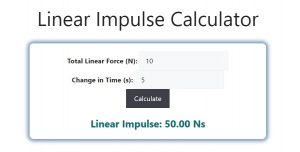About Linear Impulse Calculator (Formula)
The concept of linear impulse is crucial in physics and engineering, especially when analyzing the effects of forces acting on objects over time. Linear impulse quantifies the change in momentum of an object resulting from a force applied for a specific duration. Understanding linear impulse can help engineers design better systems, predict object behavior, and improve safety mechanisms in various applications, from automotive to aerospace engineering. The Linear Impulse Calculator provides an easy way to compute the linear impulse by taking into account the total linear force and the time duration over which the force is applied.
Formula
The formula for calculating linear impulse is:
Linear Impulse = Total Linear Force * Change in Time.
How to Use
- Determine Total Linear Force: Measure or calculate the total force applied to the object in newtons (N).
- Measure Change in Time: Record the time duration in seconds (s) over which the force is applied.
- Input Values: Enter the total linear force and change in time into the Linear Impulse Calculator.
- Calculate: Click the “Calculate” button to find the linear impulse value.
Example
For instance, suppose a force of 10 N is applied to an object for 5 seconds. To calculate the linear impulse:
Linear Impulse = Total Linear Force * Change in Time
= 10 N * 5 s
= 50 Ns.
Thus, the linear impulse generated is 50 Newton-seconds (Ns), indicating the momentum change imparted to the object.

FAQs
- What is linear impulse?
Linear impulse is the product of a force applied over a period of time, resulting in a change in momentum. - Why is linear impulse important?
It helps in understanding how forces affect the motion of objects, crucial in fields like mechanics and dynamics. - How is linear impulse related to momentum?
Linear impulse is equal to the change in momentum of an object when a force is applied over time. - Can linear impulse be negative?
Yes, if the force applied acts in the opposite direction of the object’s motion, the impulse can be negative. - What units are used for linear impulse?
Linear impulse is measured in Newton-seconds (Ns) or kilogram meters per second (kg·m/s). - How do you measure total linear force?
Total linear force can be measured using a force sensor or calculated using Newton’s second law (F = ma). - What factors affect linear impulse?
The magnitude of the applied force and the duration for which it acts determine the linear impulse. - Can linear impulse be applied to rotational motion?
Yes, the concept of impulse extends to rotational motion, where it is referred to as angular impulse. - What is the difference between impulse and force?
Impulse is the effect of a force acting over time, while force is the instantaneous interaction that changes an object’s motion. - How can I apply this concept in real life?
Linear impulse is used in sports to understand impacts, in automotive safety to analyze crash forces, and in engineering to design machinery. - Is linear impulse the same as momentum?
No, linear impulse measures the change in momentum, while momentum is the product of mass and velocity. - How does linear impulse affect vehicle collisions?
In collisions, the impulse experienced by vehicles helps determine the forces involved and the resulting damage. - What role does time play in calculating linear impulse?
The duration of force application is critical; a longer time results in a greater impulse, hence a larger change in momentum. - Can linear impulse be calculated if the force varies?
Yes, if the force varies, the total impulse can be calculated using the area under the force-time graph. - What is the impulse-momentum theorem?
The impulse-momentum theorem states that the impulse applied to an object equals the change in its momentum. - How can I visualize linear impulse?
Graphs plotting force versus time can visually represent linear impulse as the area under the curve. - Does linear impulse apply in non-contact scenarios?
Yes, linear impulse can apply in scenarios involving gravitational or electromagnetic forces acting over time. - What is the significance of calculating linear impulse in sports?
Understanding linear impulse can enhance performance techniques, optimize equipment design, and improve athlete safety. - Can I calculate linear impulse in a vacuum?
Yes, linear impulse can be calculated in a vacuum as it primarily depends on force and time, not the surrounding environment. - Are there software tools to calculate linear impulse?
Various physics simulation software tools can help visualize and calculate linear impulse in different scenarios.
Conclusion
The Linear Impulse Calculator is a valuable tool for understanding and analyzing the effects of forces on objects over time. By accurately calculating linear impulse, individuals and professionals in physics, engineering, and related fields can gain insights into momentum changes, optimize designs, and improve safety measures. Regularly using the linear impulse concept helps reinforce the relationship between force, time, and motion, leading to better-informed decisions in various applications.